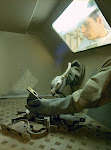I was recently asked what I thought were the best books on
the topic of leadership, which is a difficult question to answer. It is almost
as difficult to answer as what is my favorite album of all time. There are so
many good ones; how does one pick a favorite? To assist me in my answer, I
thought I would search the Internet for other lists of top works on leadership
and compare the search results to books I’ve put in that category. What I
discovered was very surprising. There were several classics on the list that
one would expect, like
Man’s Search for Meaning and
How to Win Friends and Influence People. However one book kept coming up on people’s lists that I
wouldn’t have classified as a source for the fine art of leadership. Alfred
Lansing’s book,
Endurance, was on most
of the lists as a top ten consideration. How does a book about a failed
Antarctic expedition capture the essence of leadership? And how could people in
the construction industry benefit from this story?
I read
Endurance
many years ago because I appreciate works that document the human struggle through
adversity. Books like
Anne Frank: The Diary of a Young Girl,
Into Thin Air,
and
Unbroken provide me with solace
that things could always be worse and that putting up a good fight can often be
worth it. The book
Endurance is about
a 1914 expedition lead by Sir Ernest Shackleton where 27 men under his command
attempted to become the first to cross the Antarctic continent. The expedition
failed miserably, with the ship getting engulfed in massive ice floes early in
the trip, changing the mission to one of survival. The book elegantly documents
a 20-month struggle to find food, shelter, safety, and eventual rescue. So what
are the leadership lessons to be gleaned from this work? There are many, and I
think that architects, contractors, developers, and owners in the construction
industry should practice the main principles in this book as basic business
practices.
Choose Your People
Wisely
Earnest Shackleton took a great deal of time in selecting
his crew to join him on the expedition. Although he placed a great deal of
emphasis on technical qualifications, he was more interested in the quality of
the character than the skill set. Shackleton knew that a grueling expedition
would require a group that could function as a team, had high integrity, and
could be trusted. These same principles determine success in business today.
Hiring managers are learning that work ethic and integrity will get you much
farther than expertise. It’s more common these days to see sports teams base
their recruiting on quality of character rather than the pursuit of the
superstar. The best companies in the construction industry are those that are
capable of attracting talent that can work together effectively, eliminate
drama, embrace a challenge, and have fun while doing it.
Your People Come
First
Throughout the story of Endurance, Shackleton is focused on
making decisions that will save his crew from their devastating circumstances.
Every decision he makes is in the best interests of the group. He had to make
many personal sacrifices and risk his life throughout the mission to accomplish
this feat. Shackleton knew that his motivation and influence on the group’s
welfare was not just necessary for survival, but more importantly, it served as
a good example for everyone involved. The only way to gain commitment from the
team is to show commitment yourself. If your people feel that you care for
their well being and success, they are much more likely to display the same care
for their work associates. The essence of “we are all in this together” is a
powerful force for any business.
Flexibility is
Essential for Success
From the very start of the expedition, Shackleton had to
change his goals depending upon changes in circumstances. He had to adapt to
losing the ship, finding secure refuge, securing food and water, and searching
for rescue. He also had to communicate the constantly changing plans to the
team so they would cooperate on working toward the tasks at hand. The
construction industry is ripe with change. During the latest recession many
companies were thrown into survival mode similar to the Endurance team. Changes in the economy, design tastes, market
movements, availability of financing, etc., require the construction industry
to keep on its toes and adapt to the new challenges. Your ability to change
gears in the construction industry can make all the difference in the world.
Maintain Optimism in
the Face of Adversity
I am sure that Shackleton questioned many times during the
group’s travails whether the crew would make it home safely, but he never let
anyone know that he doubted their success. He knew that if he displayed any
indication of hopelessness, the team would quit the fight, disband, or even
mutiny. A realistic optimism is essential to survive in business or to grow
into new arenas. The construction industry is littered with challenges; legal
issues, safety concerns, and labor matters to name a few. Maintaining optimism
from the top is essential if it is going to permeate throughout the ranks.
Everyone needs to believe that no matter how daunting the challenge, the team
is capable of achieving the progress needed to meet their goals.
I still find it amazing that an expedition that occurred
over 100 years ago would serve as a guideline for effective business leadership
today. Although I certainly don’t practice all of these principles as
effectively as I would like in my daily activities, the voyage of a small crew
of adventurers gives me hope to continue the struggle for success. I think that
all of us in the construction industry would benefit from reading this book and
adopting some of the principles in our day-to-day practices.











